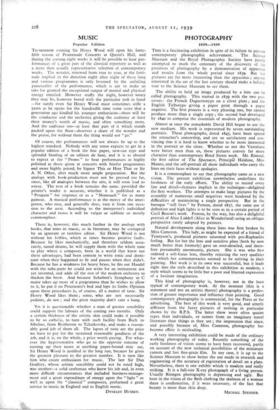PHOTOGRAPHY
1839-1939
THIS is a fascinating exhibition in spite of its failure to present contemporary photographic achievement. The Science Museum and the Royal Photographic Society have jointly attempted to mark the centenary of the discovery of the processes of photography by a demonstration of apparatus and results from the whole period since 1839. But the pictures are far more interesting than the apparatus ; anyone interested in the art of the last century should make a holiday tour to the Science Museum to see them.
The ability to hold an image produced by a lens can be called photography. This started in 1839 with the two pro- cesses: the French Daguerrotype on a silver plate ; and the English Talbotype giving a paper print through a paper negative. The first process is a very pleasing one, but cannot produce more than a single copy ; the second had developed by 1840 to comprise the essentials of modern photography.
Almost at once the remarkable David Hill began to use the new medium. His work is represented by seven outstanding portraits. These photographs, dated 1845, have been spared the retoucher's censorship, and are so satisfactory and con- vincing that it is hard to know whether to be more interested in the portrait or the sitter. Whether or not the Victorians were better men than us, these pictures convey far more character than contemporary Bond Street work. Mr. Rintoul. the first editor of The Spectator, Principil Haldane, Miss Munro, and the self-portrait all show individuals who carry the lines on their faces without apologies.
It is a commonplace to say that photography came as a new vision. The present exhibition nevertheless underlines the freshness of the early efforts. The ability to record every line and detail—features implicit in the technique—delighted the first workers. The attempts to make large pictures by the assembly of numerous small negatives were hindered by the difficulties of maintaining a single perspective. But in the baroque "still lives" by Fenton, dated 1857, the same use of definition and high lights is to be seen as in a certain period of Cecil Beaton's work. Fenton, by the way, has also a delightful portrait of Alice Liddell (Alice in Wonderland) using an oblique perspective rarely adopted by painters.
Natural development along these lines was first broken by Miss Cameron. This lady, as might be expected of a friend of Tennyson's, produced pictures saturated with pre-Raphaelite feeling. But for her the lens and sensitive plate (both by now much better than formerly) gave an over-detailed, and there- fore presumably unromantic, picture. She it was who first ordered a soft-focus lens, thereby rejecting the very qualities for which her contemporaries seemed to be striving in their painting. Her work is in its own way successful, but it leads right into the style described in this exhibition as modern, a style which seems to be little but a poor and blurred expression of a hesitant imagination.
This kind of photography is, however, not in the least typical of contemporary work. At the moment (this is a statement and not an artistic theory) photography is a profes- sion of greater importance and influence than painting. Good contemporary photography is commercial, for the Press or for advertising. The best of this work is very good, and utterly different from the fuzzy pictures of nothing in particular shown by the R.P.S. The latter show more often quaint types than individuals, or scenes from an imaginary travel literature than things as they are ; the impression that since, and possibly because of, Miss Cameron, photography has become effete is misleading.
A very interesting exhibition could be made of the ordinary working photography of today. Recently something of the early freshness of vision seems to have been recovered, partly on account of the new technical possibilities of the miniature camera and fast fine-grain film. In any case, it is up to the Science Museum to show better the use made in research and engineering of the accuracy of registration of detail on a plate. Nevertheless, there is one exhibit which is modern and really striking. It is a full-size X-ray photograph of a living person. Usually Röntgen photography is depressing and ugly. But here in the vision of the flesh clothing the skeleton of a woman there is confirmation, if it were necessary, of the fact that beauty is more than skin deep..
1V1IC.HAEL SPENDER.








































 Previous page
Previous page